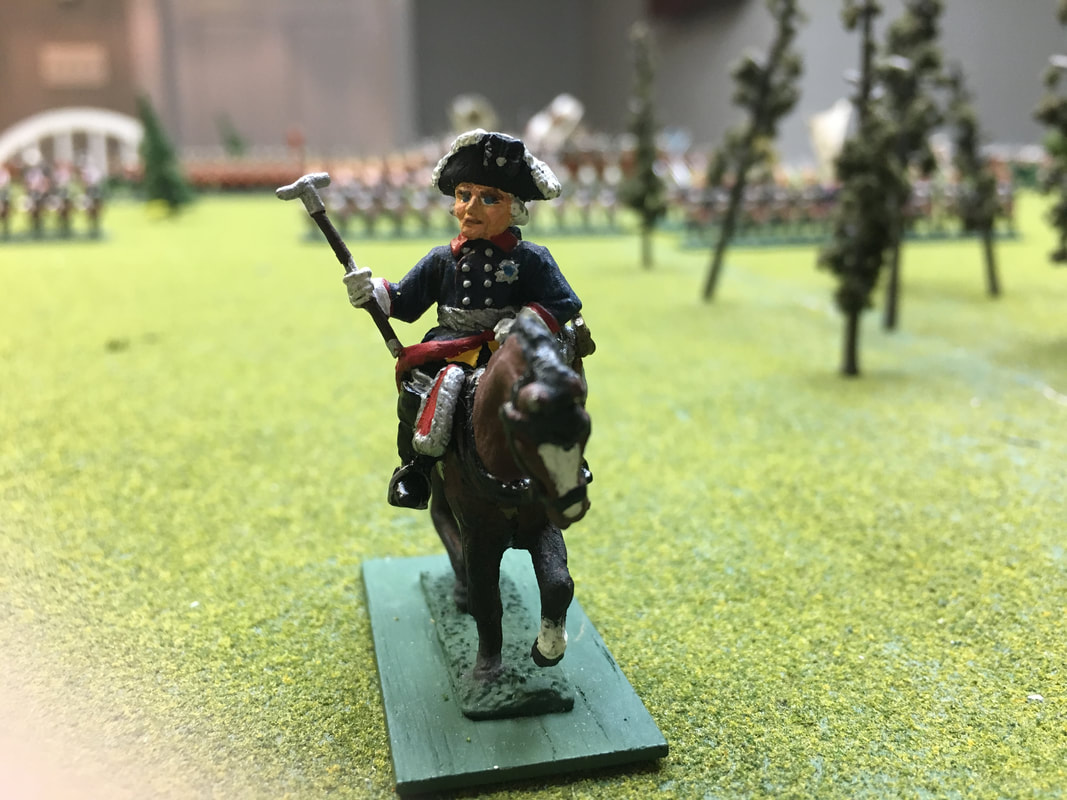|
1758 On the Brandenburg Plain: A Fictional 3rd Silesian War Battle
Premise: Frederick turns to save his capitol from the invading Russians. Unfortunately for the Russians diarrhea has “run” through the ranks of the senior officers leaving a Cossack, Hetman Platov, as the senior officer. Frederick meets the Russians somewhat dispersed and is able to offer battle with even numbers. This, for the less well-drilled Russians, spells ruin. Both armies deployed in a long double line of sixteen battalions each on either side of three small hills. The terrain was otherwise unremarkable, being used by the locals as pasturage and wheat fields. The armies deployed symmetrically with each placing a 6-pounder battery between the southernmost and central hill and a 12-pounder battery between the center and northernmost hill. As they maneuvered to contact the Russian 12 and the Prussian 6 deployed early. At a range of about 600 yards the 12-pounder began bowling the Prussian Grenadier Battalions of Unruh and Burgdorff. Prussian gunnery was initially as good with the 6-pounder causing casualties and disorder in the Narva Regiment at the same range. For the rest of the afternoon the two batteries would fire at these two targets with distinctly different results. While the grenadiers would suffer over 360 casualties to the long-range fire they never wavered and were ever-present as a reserve if needed from the musketry battles raging to their left and right. Narva, on the other hand, would never recover, suffering only 10% losses (57 men) but deteriorating in their order as the bombardment continued, eventually running from the field in disgrace without ever nearing an enemy unit. On the southern end of the field Regiment Markgraf Karl faced off against Rostov and Regiment von Bevern faced Astrakhan across a broad, gentle slope covered in young wheat. Here the normal stoicism of the Russian foot soldier was in full evidence against the superior firepower of the Prussian musketeers. In over an hour of musketry exchange, over 400 Russians fell to color the wheat red, only at the very end did the 1st Battalion of Rostov finally fall back from the fury. The Prussians suffered only 111 casualties. In the center Platov sent Musketeer Regiment Apcheron and his brigade of converged grenadiers against the Fusilier Brigade von Wied and Olde Six. Wied found itself outgunned and finally 2nd battalion was forced to fall back to reform. This allowed Apcheron to pivot on Olde Six which was still standing having outdueled two battalions of Russian grenadiers. In the end Apcheron was forced to withdraw as all of their supports abandoned them and the Oesterreich Grenadiers marched forward under Frederick’s careful eye. Olde Six suffered over 350 casualties while inflicting 446 on three different Russian grenadier battalions and forcing them all to fall back before the blind discipline of Freddy’s Guard Grenadiers. It was on the northern flank, across a small hill that had, until that morning, been a resting place for cattle in the summer sun, where the battle was decided. Here the two battalions of the Regiment von Itzenplitz utterly destroyed a brigade composed of two battalions of Russian Guards and two battalions of the St. Petersburg Musketeer Regiment. 1st Itzenplitz engaged the Guards while 2nd engaged St. Petersburg, each supported by a 3-pounder battery. In a gradual wearing away, the 2nd Guards, then 2nd St. Petersburg, then 1st Guards all withered away while the Prussians fired and stepped forward, fired and stepped forward, inexorably pushing even as their ranks were thinned. The Russian gunners died at their pieces and, finally, only 1st St. Petersburg was left to withdraw in order before the remnants of Itzenplitz. The brave men of Regiment von Meyrinck were never called from their supporting line. In all, the Russians suffered over 800 casualties while Itzenplitz lost 475 but held the bloodied rise and watched the crumpled Russians tuck pride and tail between their legs and skulk back to Warsaw. We use Volley Fire rules and 25mm figures for our Lace Wars games.
0 Comments
Leave a Reply. |
AuthorDiatribes are simply often humorous recountings of the games played by the Long Island Irregulars. We play with toy soldiers and are unabashedly happy to have never lost this part of our childhoods.. Archives
November 2023
Categories
All
|

 RSS Feed
RSS Feed